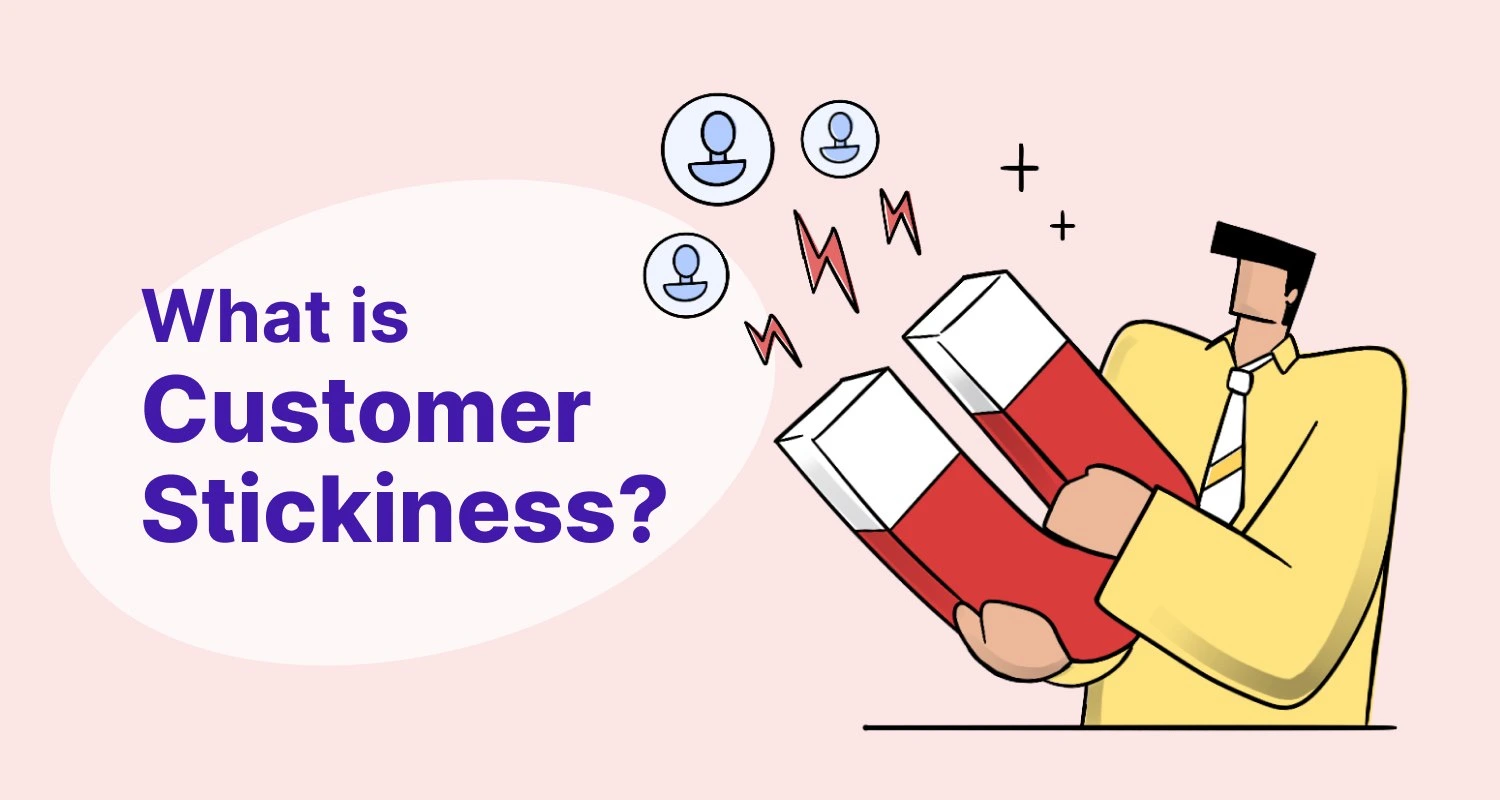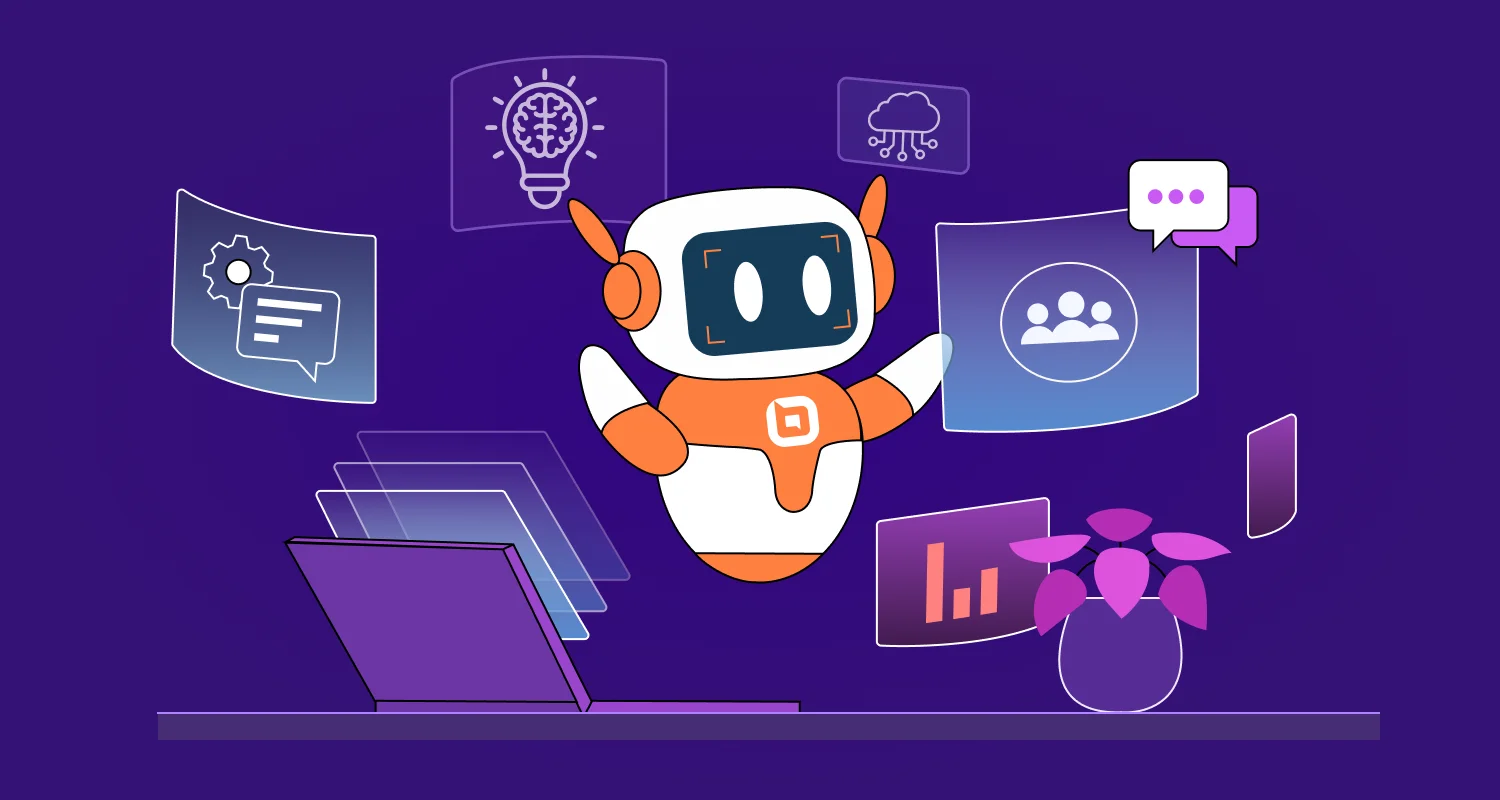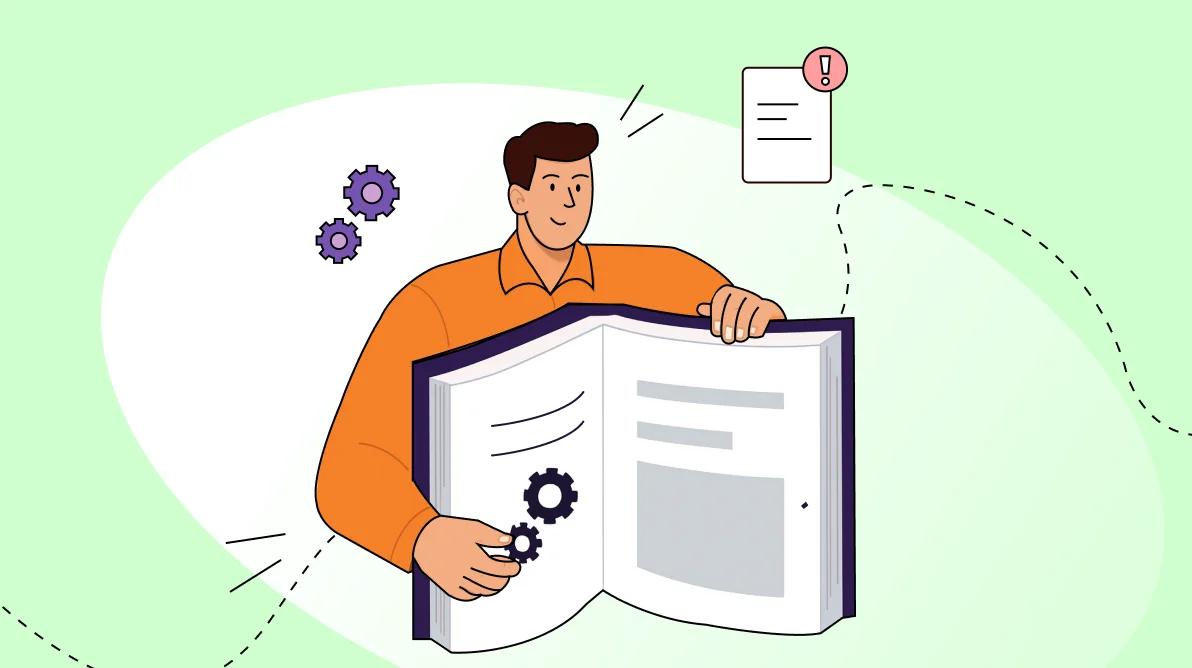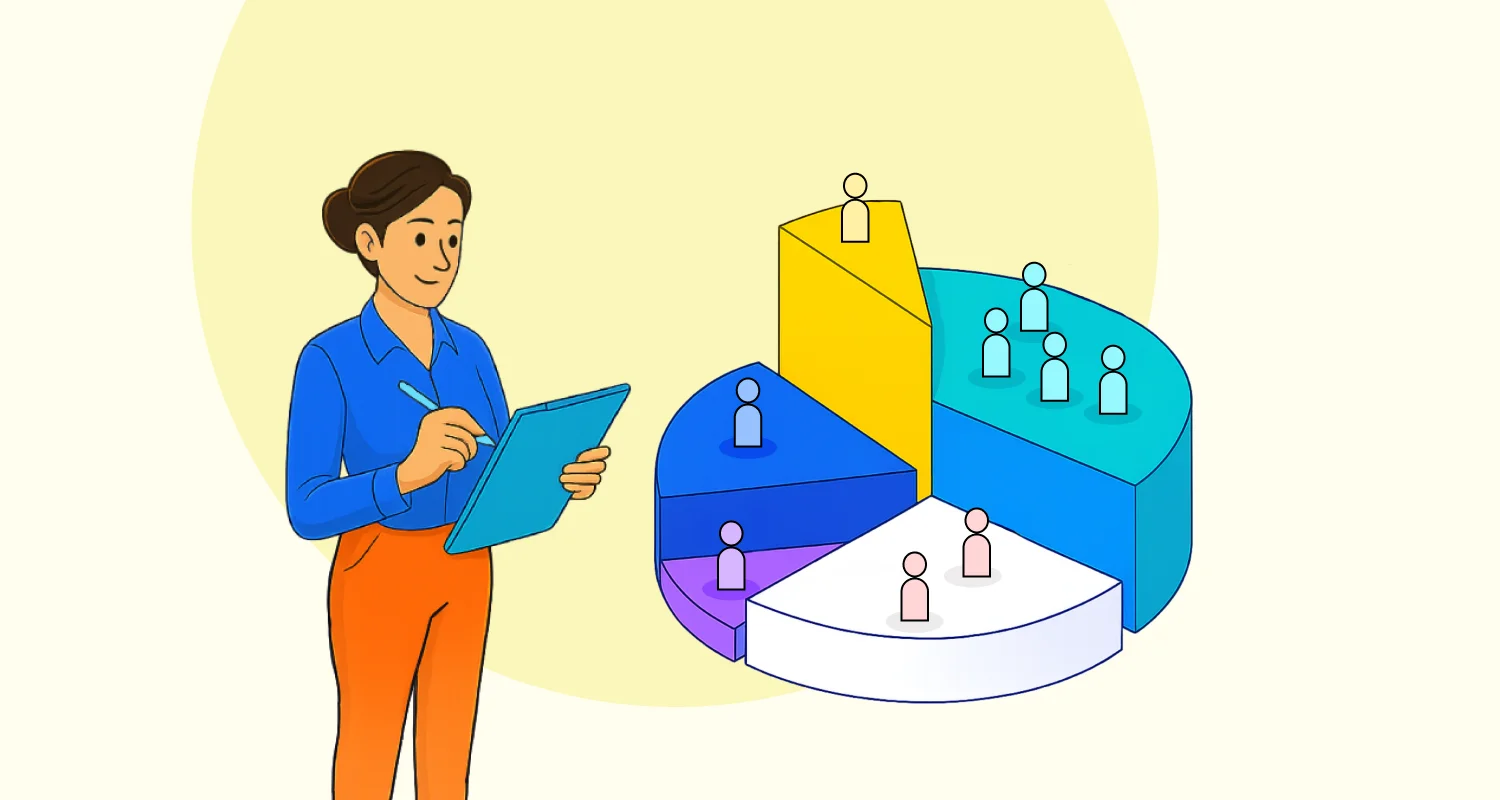Customers always have multiple options to choose from and can easily switch from one business to another with just a minor inconvenience.
The real challenge for most companies is finding the right strategies to keep them coming back and that’s where customer stickiness comes in.
It’s not just about attracting new customers but creating an experience so compelling that existing ones stay and thrive with your brand.
High customer stickiness doesn’t happen by chance; it’s a continuous process that demands consistent effort toward providing exceptional customer service.
A sticky customer base not only boosts flexibility but also drives long-term profitability.
In this blog, we’ll explore customer stickiness, strategies for improving it, and how to transform sticky customers into loyal ones.
What is customer stickiness?
Customer stickiness is a measure of how likely customers are to return to repurchase a brand and consistently choose its products or services, even in changing market conditions.
For every business, there are certain specific factors that drive customers to be sticky and return for a second, third or even fourth round.
These contributing factors for customer stickiness can be anything from the product uniqueness, exceptional customer experience, friendly pricing plans, a comprehensive range of features, and more.
Customer stickiness is the stage before loyalty, meaning if a customer keeps repurchasing your product or service, there is high likelihood of them transforming into loyal customer that eventually become passionate brand advocates.
Customer stickiness formula
Customer stickiness evaluates the likelihood of customers returning to your products or services. These loyal clients are not only likely to stay with your brand but also are less likely to switch.

Key differences: Customer stickiness vs. Customer loyalty
Although both customer stickiness and customer loyalty are important components of client retention, they are not the same.
The following are some common differences businesses should look into.
| Aspect |
Customer stickiness |
Customer loyalty |
| Definition | The likelihood of a customer staying with a product service or brand over time. | A customer purchases a product continuously due to the emotional attachment to a brand. |
| Measurement | % of returning customers who repurchased a product. | Measured as the % of clients who are loyal to the brand. |
| Strategy | Superior customer experience, regular engagement, and loyalty programs. | Meeting and exceeding customer expectations, emotional connection. |
| Focus | Concentrates on retaining clients and keeping them more engaged. | Focuses on building long-term relationships with customers. |
| Dependency on options | Customers can be easily influenced by different factors to choose other better alternatives. | Customers are less affected by other options because they prefer the specific business. |
| Customer behaviour | Customers could keep using the goods because they want to. | Customers actively support and advocate the brand. |
Strategies on how to create customer stickiness and enhance it
Every business hopes that customers will return to them after each purchase, rather than switching to competitors. For long-term success of your business, the main target should be to look for ways to ensure first time clients see the value proposition of your brand and be convinced to make repurchases. From there, you can then proceed to implement strategies to win them over and increase their customer lifetime value.
Let’s explore some of the best practices to transform sticky customers into loyal ones who become passionate advocates for your brand.
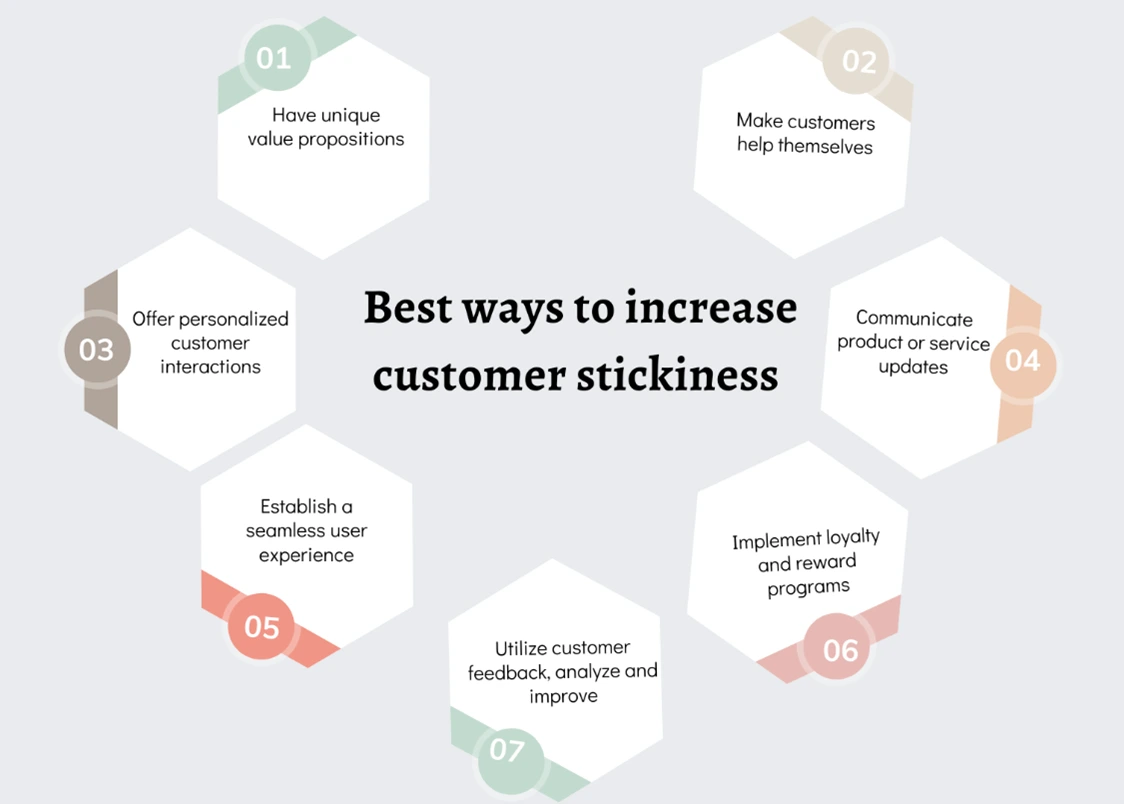
Have unique value propositions
Companies with strong values build customer loyalty when they connect with principles that resonate with the customers’ happiness.
Create a simple, clear mission that aligns with customer needs and supports your customer service philosophy.
This mission will serve as a guiding framework throughout the process, helping you identify areas that require improvement.
Ensure your support teams understand and confidently communicate these values, making customers return.
Unique value propositions highlight what makes your products special, giving customers a reason to stay.
They address specific needs, creating emotional and practical connections that competitors may miss.
With the right guidance, support teams can deliver exceptional service and increase customer value daily.
A strong unique value proposition also fosters brand advocacy, as satisfied customers are more likely to share their positive experiences with others, further reinforcing loyalty.
Offer personalized customer interactions
Everyone loves feeling special, and your customers are not an exception. Do you know your customers’ preferences, their specific pain points, or what drives their stickiness to your brand?
Get all the possible insights from customer data to ensure you give them exactly what they need, for personalized customer service experiences.
There are many ways to go about personalization to add a human touch throughout the customer interactions such as:
- Recommendations on your product offerings based on past purchases.
- Sending tailored emails such as thank you notes, sorry for the inconvenience, birthday or holiday wishes, and so forth.
- Having a dedicated agent for live chat support.
- Sharing value-driven content to address specific customer issues and more.
Every time you personalize your support or product to meet your customers’ specific needs, it makes them feel valued and understood.
This means they won’t get any second thoughts about repurchasing because of their emotional attachment; you win them over!
Make customers help themselves
Most customers appreciate feeling in control and are happier when they can solve their issues independently without needing assistance from support teams.
Empower your customers with easy-to-use resources like FAQs, troubleshooting guides, and knowledge bases, to help reduce wait times and enhance the overall experience, encouraging repeat visits.
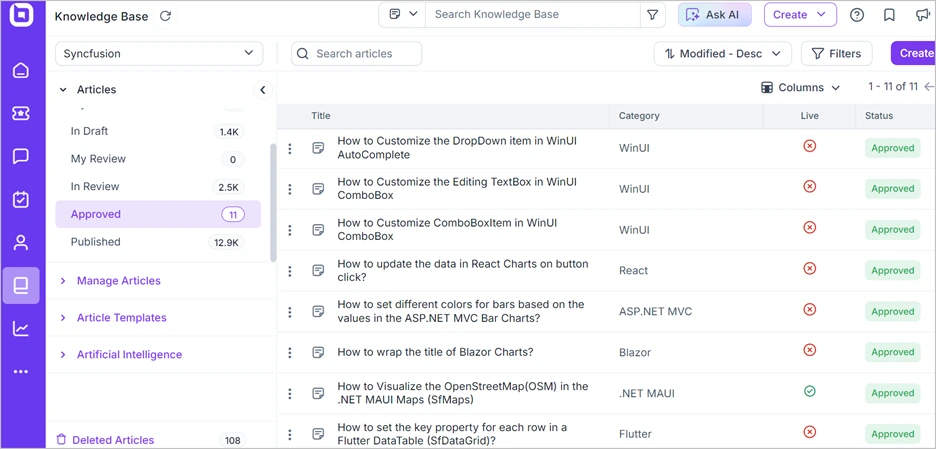
Seamless access to self-service options increases ticket deflection, and promotes frequent engagement. This allows agents to focus on complex issues, leading to higher customer stickiness.
Establish a seamless user experience
Whether online or in-store, customers always expect quick and reliable support every time they interact with your business. To meet these customer expectations, there are many ways to go about it:
- Ensure your website or app is easy to navigate, allowing customers to complete transactions without hassle. Investing in a user-friendly interface boosts engagement, reduces frustration, and encourages repeat visits. A well-designed platform keeps users exploring and coming back for more.
- Provide live chat software and mobile app support to resolve issues in real-time, empathetically addressing customer concerns. This enables support teams to assist customers anywhere, anytime.
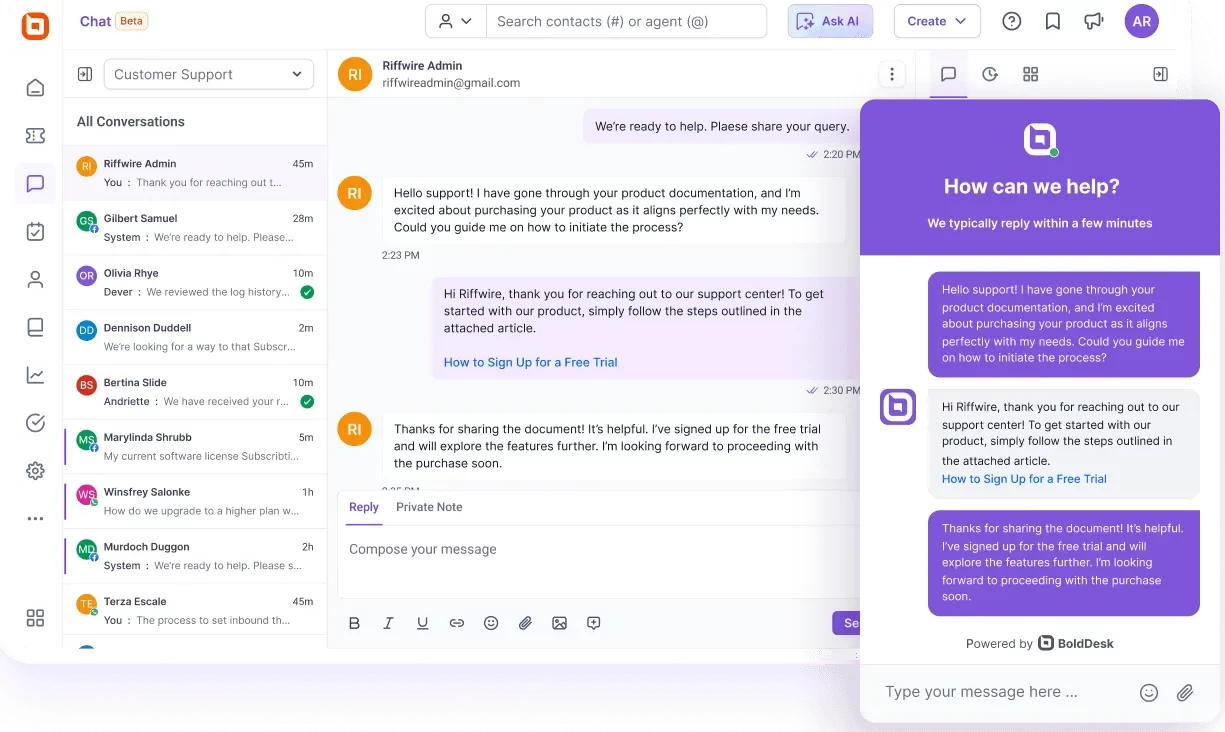
- Finally, reliability is key. Consistently delivering excellent service and quality builds customers’ trust and confidence in your brand. This assurance of reliability and always getting quality becomes a great motivation for them to stick with your business.
Communicate product or service updates
How often do you communicate with your customers and how good is the interaction?
Make it a habit to encourage open interactions across various platforms like community forums, social media groups, and any other customer service channels.
Encourage your support agents to use a friendly and approachable tone, making customers feel at ease to always discuss their issues freely. Being comfortable means they are more likely to stick to the brand.
With multilingual support, your team can engage empathically with customers worldwide in their preferred language, offering quick, personalized responses.
Regularly updating your products or services and quality of support shows you are scalable, care about always meeting customer expectations, inform end-users about new features, and can also re-engage inactive users. These updates create excitement that reduces customer churn, ultimately increasing customer stickiness.
Implement loyalty and reward programs
Appreciation has a way of making anyone, including customers, to feel valued and connected to the businesses they support.
Consider implementing coupons and loyalty programs as an effective way to incentivize customer sentiments and enhance engagement.
Use strategies like offering incentives, discounts, exclusive deals, or points for every subscription to encourage repeat purchases and build long-term relationships.
Loyalty programs not only keep customers coming back but also have the power to turn casual shoppers into brand advocates.
Utilize customer feedback and make continuous improvement
Customers tend to stick with companies for various reasons, such as cost, quick support, or unique features that competitors don’t offer.
To understand why they stay and continue to make repeat purchases, it is important to ask customers what attracted them to choose your product, and which specific features keep them loyal to your brand. This knowledge will help you to focus on delivering exactly what your end-users prefer.
You can gather insights by monitoring customers’ behaviour and collecting feedback through online surveys, comment sections, community forums, and in-app ratings.
Tracking their activities helps you identify what drives engagement and satisfaction, showing that you genuinely care about their needs and pain points.
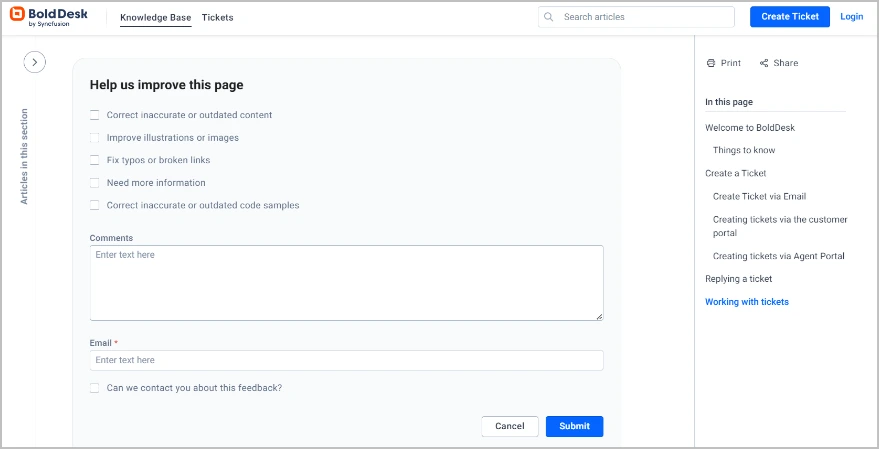
Regularly reaching out for feedback not only demonstrates that their opinions matter but also helps you make necessary adjustments.
Finally, customers appreciate knowing their input shapes product and service development, making them more likely to stay engaged.
Real-world examples of customer stickiness
To keep customers engaged, satisfied, and loyal successful companies use various approaches to personalized experiences, stand out, and build lasting relationships.
Here are a few examples of customer stickiness that businesses can learn from:
Spotify
Spotify is a digital music service that connects customers worldwide, offering access to millions of songs and personalized listening experiences.
It excels at customer stickiness by offering personalized playlists and suggestions based on listening habits.
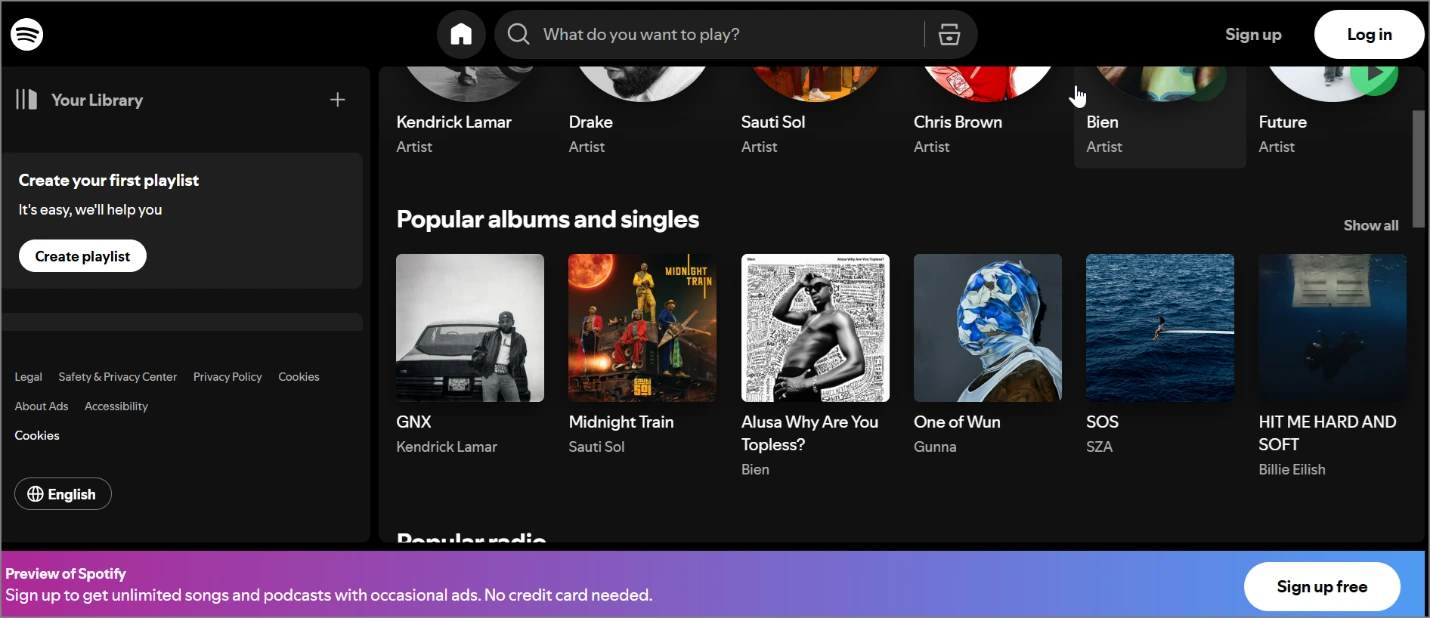
The platform helps users engage with the content regularly by providing a customized music experience. In addition, the social sharing features encourage community touch, keeping customers connected and happy.
Nike
Nike is a globally recognized sportswear and athletic brand specializing in designing, manufacturing, and marketing footwear, equipment, and accessories.
It focuses on creating emotional connections through its products, personalized experiences, and a robust loyalty program that ensures customers feel connected to.
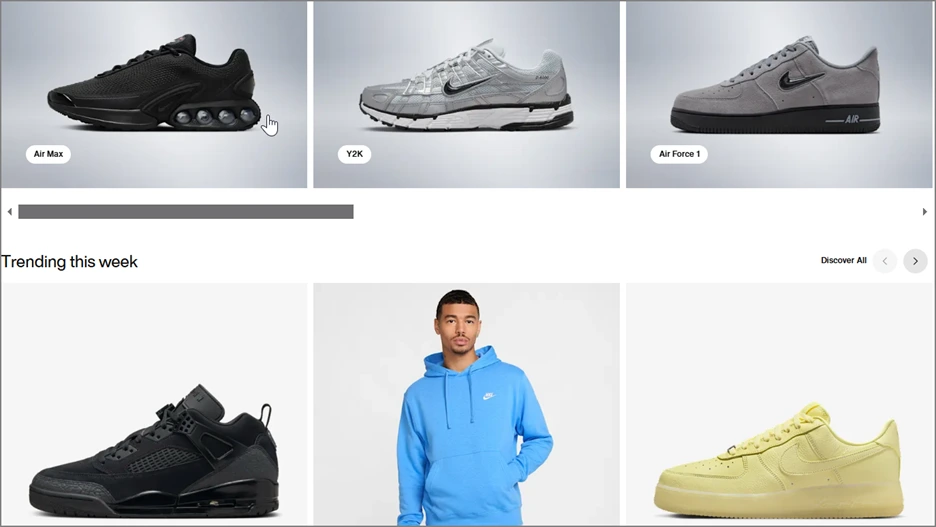
With Nike+, their app tracks activity and rewards customers with personalized offers, deepening their engagement and loyalty.
Dropbox
Dropbox is an online file storage and collaboration platform that lets you access, edit, sign, store, and share files securely from anywhere.
The platform creates customer stickiness by offering smooth cloud storage solutions and collaborative features for the support team.
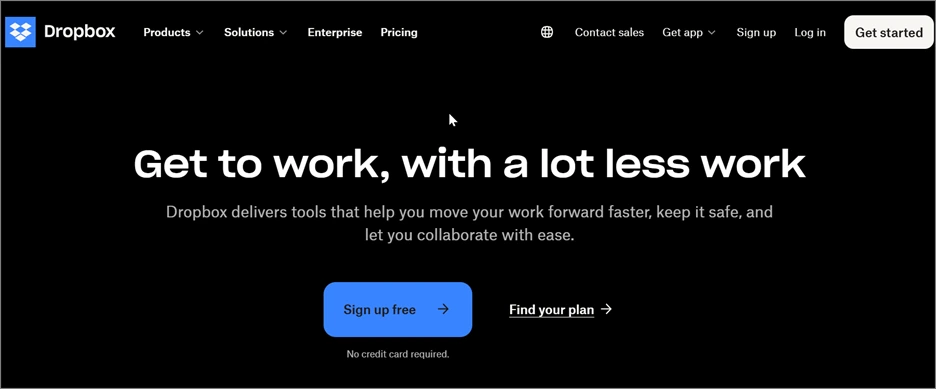
Regular updates and enhanced security measures keep users happy and let them remain subscribed to the services.
Their successful referral program attracts new mysteries to the existing customers and integrates them into their step-by-step workflow.
Why customer stickiness is crucial for SaaS and service companies
The success of SaaS and service companies relies on their ability to retain users over time. Unlike one-time purchases, these businesses rely on recurring revenue and ongoing customer engagement to sustain growth.
The following outlines a few reasons why you should consider prioritizing customer stickiness.
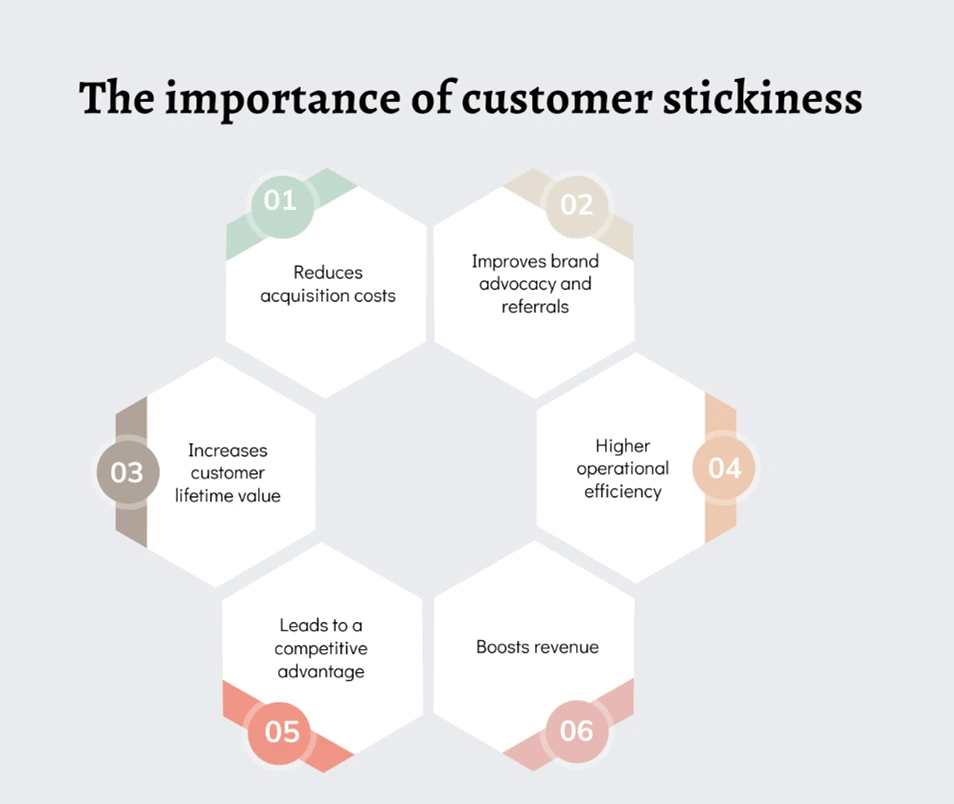
- Reduces acquisition costs: When customers stick around, they reduce the amount needed to spend on marketing and acquiring new customers. This demonstrates that more resources can be used to improve service and engage with customers.
- Improves brand advocacy and referrals: Sticky customers are more likely to become brand advocates. When customers stick to the business, they may help create a strong community that drives rapid growth through positive word-of-mouth recommendations to their friends, colleagues, and families, increasing brand awareness.
- Increases customer lifetime value: Customers who stick around tend to spend more over time, which boosts the overall lifetime value of SaaS businesses. Businesses can use customer lifetime value metrics to enhance their customer service experience, services, or products and develop tailored solutions.
- Higher operational efficiency: Engaged customers have greater chances to offer helpful feedback that can be applied to enhance products, services, and interactions. This results in fewer mistakes and increases operational efficiency in customer service operations.
- Leads to a competitive advantage: When customers feel special and connected they are less likely to switch to competitors, creating barriers to entry for startup companies. This competitive advantage can lead to long-term business success and market leadership.
- Boosts revenue: Sticky customers spend more when they stay for longer periods of time and come back for more to make repeat purchases. Therefore, SaaS businesses can increase customer loyalty and boost profits by prioritizing product or service stickiness.
How to measure customer stickiness
Given the numerous factors involved, measuring customer stickiness can be quite complex. However, the following are a few key indicators that can be helpful.
Customer satisfaction score (CSAT)
Customer satisfaction scores (CSAT) assess how satisfied your customer are with your product or service. A high satisfaction level score indicates higher stickiness.

Customer retention rate
This metric assesses the percentage of clients that a business could retain over a specified period.
A higher customer retention rate shows that customers prefer sticking with the brand rather than seeking alternatives.

E- Customers you have at the end.
N- Customer acquired during the measuring period.
S- Customers you have at the start.
Tracking this CRR metric regularly can help identify customer service trends that lead to higher likelihood of customer stickiness.
Net promoter score (NPS)
Net promoter (NPS) score monitors customer loyalty and how likely customers recommends your brand to others.
A high NPS often indicates strong customer stickiness, as satisfied customers willing to promote your business are less likely to leave.
By collecting NPS feedback, businesses gain valuable insights into customer sentiment and the emotional drivers behind brand loyalty. These insights can guide smarter decisions and help build lasting relationships.

While manual NPS calculations are possible, alternatively, support teams can save time and boost accuracy by using tools like BoldDesk’s Free NPS Calculator a simple, automated way to get reliable results without the hassle.
Customer lifetime value (LTV)
Calculates the total revenue a business expects from customers throughout their relationship.
A high customer lifetime value shows that more end users remain engaged and continue to spend, indicating stronger stickiness.

This metric helps businesses assess the effectiveness of their retention strategies and makes forecasting revenue more accurate.
Churn rate
Customer churn rate is the total percentage of customers who leave you to go your competitors over a particular period.
A lower churn rate signifies higher customer stickiness, as it reflects the satisfaction and commitment of the customer base.

Monitoring customer churn rates can highlight potential weaknesses in customer happiness and support strategies aimed at retaining customers.
Repeat purchase rate
Measures how often customers make repeat purchases from your company. A more repeat purchase rate is a strong indicator of customer stickiness.

Engagement metrics
Evaluate the level of customer investment in your products, services, or brand. Businesses can monitor metrics such as logins, usage frequency, and feature activity to gain insight into customer engagement.
A high level of customer interaction indicates stickiness, as customers who actively use the service are likely to be loyal.

Analyzing these customer engagement metrics can help businesses tailor their products or services to enhance customer service experience.
Turn customer stickiness into loyalty for business success
Rather than focusing only on acquiring new customers, it’s important to make it easier and more convenient to keep existing ones.
By consistently improving your products and services, you can build a stronger, loyal customer base that will keep customers around for longer periods.
Therefore, it is essential to recognize the value of loyal customers and implement effective strategies to increase engagement, encourage them to stay, and ensure market growth and sustainability.
Organize a live demo to discover how BoldDesk can help you provide excellent customer support to your clients every time they contact you for help. Start a 15-day free trial to explore its numerous features. If you have any questions. If you have any questions, please contact the support team built on BoldDesk.
Related articles
- What is Customer Focus? – Definition, Best Strategies and Examples
- How to Create Customer Service Policies Effectively
- 7 Best Techniques for Reducing Customer Service Response Time
Frequently Asked Questions (FAQs)
Customer stickiness vs customer retention
The customer stickiness meaning is the ability of a product, service, or brand to consistently keep customers engaged and coming back. This is because they offer something unique, convenient, or emotionally satisfying.
Customer retention refers to a business’s capability to retain its customers for longer and prevent them from shifting to competitors.
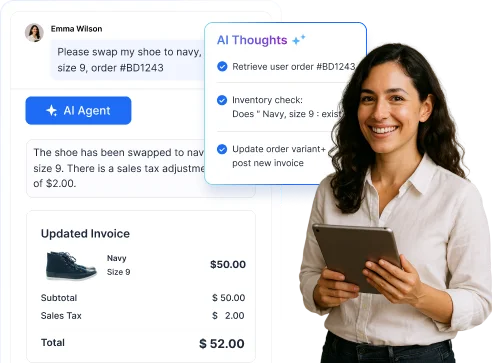


















 Email Ticketing System
Email Ticketing System Shared Inbox Software
Shared Inbox Software Multi Brand Help Desk
Multi Brand Help Desk Internal Help Desk Software
Internal Help Desk Software Trouble Ticketing Software
Trouble Ticketing Software Mobile Help Desk
Mobile Help Desk 










